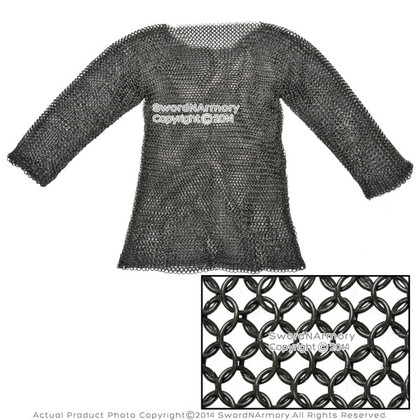Armor & Chainmail Maintenance Tips 101
Posted by Sword N Armory on Jul 8th 2019
Congratulations! If you're reading this
article you almost certainly have just entered the exciting world of ancient armor; perhaps your
first chainmail purchase is sitting before you right now, begging
to be opened.
In the Good Ol’ Days
Of course, most of us who like to imagine ourselves fighting in armor on the battlefields of the good old days do not think we will have to maintain our own equipment. We like to think that we will have squires or pages or some kind of dedicated helper to manage such details while we concern ourselves with battle and courtly manners. However, self-maintenance or not, the process of olden times was neither complex nor technical.
Sand mixed with some grease or oil was used to clean armor and chainmail. Lucky armor maintainers had sand tumblers available to clean their chain mail and would hand-clean sheet armor with this sand/oil mixture.
Maintaining your own Armor and Chainmail
Moisture is the enemy of armor and chainmail. To prevent rust, remove any moisture as soon as you possibly can using entirely dry paper towels or rags or the strong, bright, warming sun. Being conscious of preventing moisture from remaining on your armor will save you hours of maintenance.
When you open your armor, you may be overwhelmed by the smell of grease. To rust-proof your purchase, the owner probably saturated it in oil.
De-Greasing: Fussy Rather than Difficult
The best way to have an uncomplicated, successful degreasing is to schedule your degreasing for a day on which you have ample amounts of strong, warm sunlight to assist the process.
Fully submerge your chainmail in a degreasing product and use your hands to agitate the metal in the solution; it’s actually a kind of fun activity; the links make an attractive sound as you move them.
Spot check the metal for grease. When you think you have removed all of the oil, take it outside and lay it on a concrete or other rust-resistant surface to dry. Reposition the mail at intervals to allow the sun to completely dry the metal.
For plate armor, rather than immersing, use a rag to liberally apply the degreaser, drying each section as your complete it. Concentrate on any areas that have rivets or overlapping metal to ensure complete drying.
A good sun substitute is a hair dryer or heat gun, though they are time-consuming.
Apply a Protective Coating
Once your armor is completely dry, use a dry rag or paper towels to apply a coating of wax or similar – there are many products from which to choose. Try not to expose the metal to water while you work; for example, do not use a rag that is already wet.
At the conclusion of this phase, you will be storing your armor until its next use. Many people designate an old towel or large rag to act as the foundation on which you apply the coating and the covering in which you store it. Cover and store your clean armor in a dry place.
Whichever way you choose to store your armor and chainmail, check it at intervals to ensure it is still dry and rust-free. This is certainly a case where prevention is the absolutely best way to fight the enemy: rust.
Finally, Polishing Your Armor
Unless your armor is for display only, don’t polish it to a mirror-like shine. To achieve that look, you would have to compromise its usefulness through buffing and polishes. Super-shiny armor is ahistorical, and you can only achieve that finish through copious amounts of elbow grease that would be better applied to battling rust.












